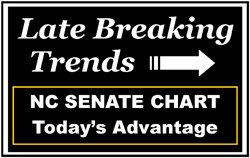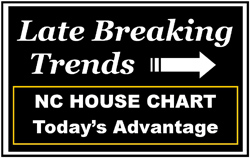Key Trends and their Impact on North Carolina’s 2010 General Election Races Advantage Democrats Advantage Republicans “These are Obama voters. These are not Democratic voters.” Democratic pollster Cornell Belcher, Washington Post: August 13, 2010 President Obama’s “Job Approval” ratings at the beginning of his administration hovered at 70% in most national polls, with less than
[More…]
 |
 |
|
Key Trends and their Impact on North Carolina’s 2010 General Election Races
|
|
“These are Obama voters. These are not Democratic voters.” Democratic pollster Cornell Belcher, Washington Post: August 13, 2010
President Obama’s “Job Approval” ratings at the beginning of his administration hovered at 70% in most national polls, with less than 20% of Americans disapproving. Now, Obama’s “Job Approval” ratings average 44%, with 49% disapproving according to today’s Real Clear Politics rolling average.
How important is a trend like the president’s job approval? Since 1946, according to Gallup, “presidents with job approval ratings below 50% at the time of midterm elections have seen their parties lose an average of 36 U.S. House seats, compared with an average loss of 14 seats for presidents with approval ratings above 50%.” For example, President Clinton’s job approval was 46% during his first mid-term election in 1994, leading to a loss of 53 Democrats in the US House. In 1998, Clinton’s job approval was 20-points higher at 66%, leading to gain of 5 seats in the US House.
Trends are a big deal. They are especially useful in establishing and tracking which party has a political advantage … an advantage that morphs into momentum that drives turnout that determines winners in many close races.
That’s why I have developed a new feature called, Late Breaking Trends – Impact on North Carolina’s 2010 General Election Partisan Political Advantage. There is one for the NC Senate and one for the NC House. That is because of trends like “Contributions” that vary by chamber.
Late Breaking Trends will be updated daily … real time as news breaks about changes like the economy, underemployment, satisfaction with the direction of the state and nation, and the partisan preferences of the all-important independent voters.
Each day I will update the NC Senate and NC House Late Breaking Trends, and highlight one or two of the trends for purposes of amplifying their political significance. Today’s highlight is:
Highlighted Trend: TURNOUT Advantage Republicans ![]()
- Fact 6/21: Republicans enjoy the highest partisan “enthusiasm advantage” ever recorded by Gallup, and have sustained that advantage all year. Republicans have a positive net of 14 points on Gallup’s “more enthusiastic than usual about voting” question; Democrats have a negative net of 21 points.
- Fact 7/16: Republicans are more enthused than Democrats by 66% to 51% says North Carolina-based Public Policy Polling, a Democratic firm.)
- Fact 7/11: Washington Post story says Black voters are ambivalent about midterm elections. “These are Obama voters. These are not Democratic voters,” said Democratic pollster Cornell Belcher.
- Fact 6/20: New minority and young voters from 2008 are not enthusiastic this year. Democrats plan to spend $50 million to reenergize them. “What the Democrats don’t have is a candidate on the ballot named Obama. Instead, they face a political climate in which hope and exhilaration has given way to anger and disappointment.”
- Fact 5/5: The 426,000 Democrats who cast a ballot in the US Senate primary in NC this year represents a 32% decline from the 628,000 who voted in the 2002 US Senate primary [the first mid-term election of the Bush presidency], says Public Policy Polling. All of this despite the almost ½ million more Democrats on the voter registration rolls than in 2002. State Board of Elections
- Fact: Republican early-voting turnout in the NC Primary in May was 74% of 2008 turnout (74,143 in 2010; 88,931 in 2008). Democratic early-voting turnout was 26% of 2008 turnout (103,277 in 2010; 408,910 in 2008). Source: Civitas